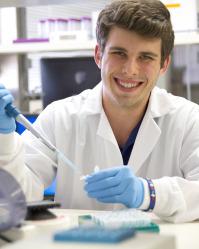
ASF Undergraduate Summer Research Grantee Dylan Ritter in the lab of Dr.Dindot at Texas A&M
I first came in contact with Dr. Dindot at Texas A&M University in the late fall of 2013 when I was a college freshman. I had seen an article published that highlighted his success in creating a mouse model used to mimic the effects of a specific kind of autism spectrum disorder, Duplication 15q Syndrome (Dup 15q). For most people reading that, the article would stand merely as an informative story about some researcher in Texas. For me, that article had a totally different context.
My youngest brother, Travis, was diagnosed with Dup15q at the age of two when I myself was only four years old. For as long as I could remember, I had a younger brother that needed help brushing his teeth, could never speak to me, and somehow enjoyed the credits of a movie more than the movie itself. I never questioned it, but I was certainly aware that our family was different from a lot of others. Meeting other families that had children with Dup15q helped me realize this condition extended beyond my five-person family, and that there was research being performed to find therapeutic options and genetic factors behind this condition.
When talking with Dr. Dindot about his research, he surprised me by ensuring me that I would be on the workbench with my own projects doing real research. And that’s exactly how the summer of 2014 was spent. I learned so much about the condition, the laboratory environment, and all of the hard work being done to find answers. I decided that I would like to return to the lab to continue research in the summer of 2015, after my sophomore year. With most of the logistics figured out from the previous summer, I was able to speak with Dr. Dindot more about what was going on in the lab rather than figuring out where his lab was on campus. In discussions about my research, he proposed that I apply for a fellowship through the Autism Science Foundation, since they were eager to support the work of undergraduate researchers interested in autism. On March 9th, I was informed that I had been selected as one of five undergraduates to receive funding for my research. It was such an exciting feeling knowing that I had been chosen by a committee as someone they believe will succeed in research. With that extra motivation, I prepared myself for the summer ahead.
I had a variety of projects going on during my time, but that main one was the classification of one of the mouse models Dr. Dindot had designed. It was set up so that excess gene expression would mimic the effects of the extra chromosomal information present in Dup15q. However, there is a unique system in which a drug could be administered in order to suppress this extra expression. The theory behind it all was that if a mouse had normal gene expression, it should have a normal phenotype without the manifestations of Dup15q. By the end of the project, it was shown that after only three days of this treatment, the excess gene expression was reduced more than 60%, showing a major change between overexpression mice and wild-type mice.
Though this was just the beginning of the project, the hope is that these mice with slightly adjusted drug treatments may eventually reach gene expression comparable with wild-type mice. From there, it is possible to perform further analysis on these mice to see if there are any phenotypic changes that occur when the gene levels change in the mouse. With the amount of progress research has made in the past 20 or 30 years, there’s no way of even being able to guess where autism research will be in the next 20 or 30 years. All I can say is that I have been extremely humbled and honored to have the opportunity to represent the Autism Science Foundation, Texas A&M, and Ole Miss by doing what I love.
